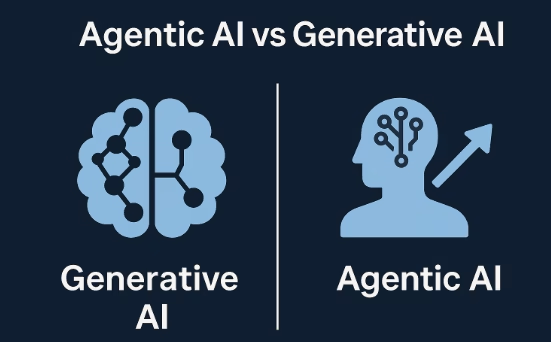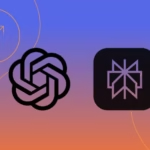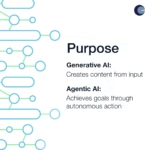Navigating the AI Landscape: Agentic AI vs. Generative AI Explained
Estimated reading time: 10 minutes
Key Takeaways
- The AI landscape is rapidly evolving, with terms like “agentic AI” and “generative AI” often causing confusion.
- Generative AI is designed to *create new content* (text, images, code) by learning from existing data.
- Agentic AI is designed to *act autonomously* to achieve specific goals, making decisions and taking actions.
- Understanding the core differences between agentic AI vs generative AI explained is crucial for grasping the future of AI automation.
- Generative AI is typically reactive and excels at discrete, single tasks, while agentic AI is proactive and handles complex, chained tasks with high autonomy.
- These two forms of AI are increasingly collaborative, with generative AI often serving as a component within agentic AI systems.
- Both will play significant roles in the future of AI automation, transforming industries and workflows.
Table of contents
- Navigating the AI Landscape: Agentic AI vs. Generative AI Explained
- Key Takeaways
- Generative AI: The Creator of New Realities
- Agentic AI: The Autonomous Actor
- The Crucial Differences: Agentic AI vs. Generative AI
- Understanding AI Evolution: A Historical Context
- The Collaborative Potential: Generative and Agentic AI Working Together
- The Future Landscape: Trends and Impacts
- Navigating the AI Frontier
Generative AI: The Creator of New Realities
The term “Generative AI” has become ubiquitous, and for good reason. At its core, generative AI is designed to create novel content. This content can take many forms: text, images, music, code, or even synthetic data. It achieves this by learning intricate patterns, structures, and relationships from vast datasets it has been trained on. Think of it as a sophisticated **representational engine** that identifies latent patterns within immense collections of data to produce outputs that are contextually sensible and often remarkably creative.
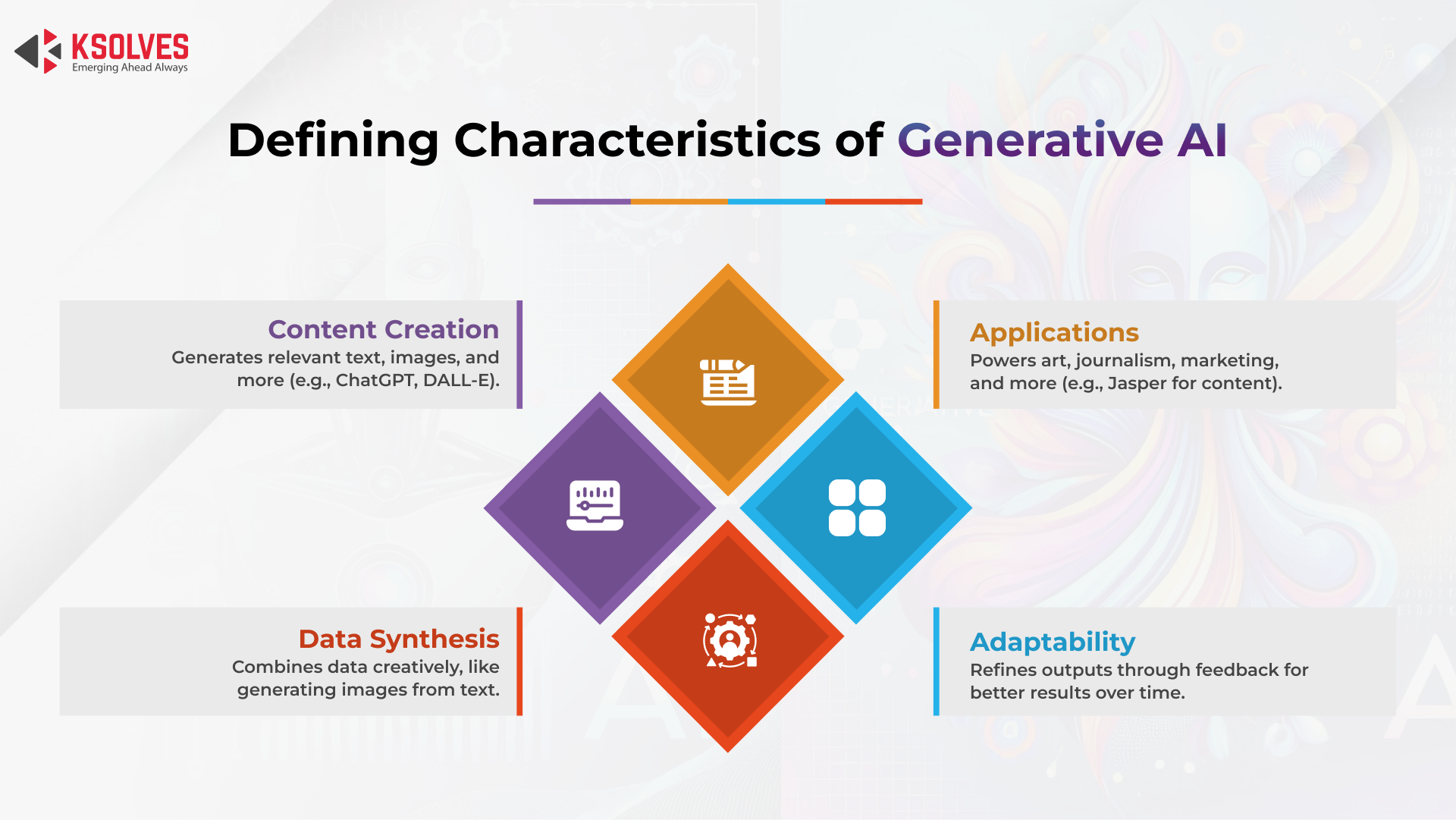
How does it work? Generative AI typically operates based on prompts provided by a user. You give it an instruction, a question, or a starting point, and it generates a response. This output is essentially a statistically probable creation based on the data it learned during its training. The more complex and nuanced the training data, the more sophisticated and diverse the generative capabilities.
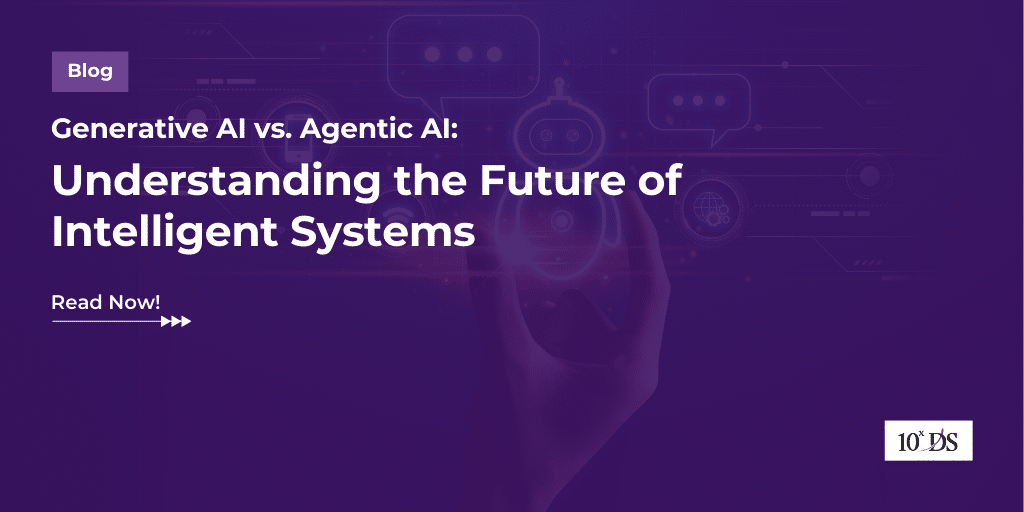
Its key characteristics include a strong emphasis on creativity and an exceptional ability for pattern recognition. It’s also fundamentally reactive; it waits for your command, your prompt, before it springs into action. Generative AI excels at **discrete, single tasks**. For instance, it can draft an email, summarize a lengthy document, or create a piece of digital art. However, it exhibits low autonomy, meaning it requires constant user direction for each subsequent step. You have to tell it what to do next.
Concrete examples abound:
- Using ChatGPT to write an email, compose a poem, or brainstorm ideas.
- Employing DALL-E, Midjourney, or Stable Diffusion to generate unique images from text descriptions.
- Leveraging GitHub Copilot to suggest and generate code snippets as you program.
- Creating synthetic datasets for training other AI models when real-world data is scarce or sensitive.

However, it’s crucial to acknowledge the limitations. Generative AI models can sometimes “hallucinate,” meaning they can produce outputs that are factually incorrect or nonsensical, despite sounding plausible. This underscores the vital importance of **careful prompting and diligent fact-checking** when using generative AI outputs.
Agentic AI: The Autonomous Actor
In contrast to the content-creation focus of generative AI, agentic AI systems are built for action and autonomy. These AI systems are designed to perceive their environment, make independent decisions, and take concrete actions to achieve specific, defined goals. They operate as an **orchestration framework**, a system that can coordinate perception, reasoning, and action. This coordination is often achieved through sophisticated planning algorithms, reinforcement learning techniques, and adaptive feedback loops that allow the agent to learn and improve over time.
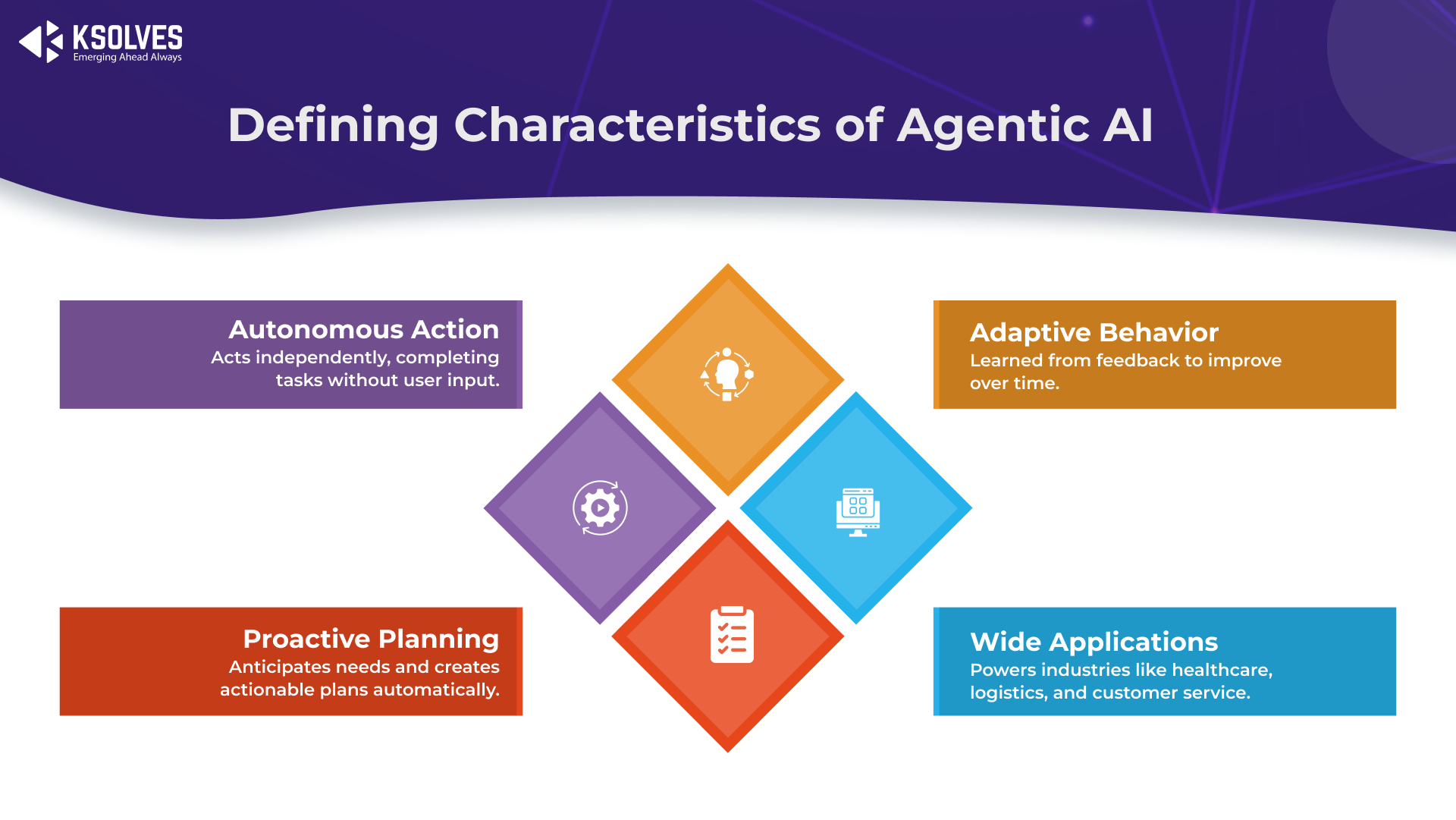
The defining characteristic of agentic AI is its ability to self-direct. It doesn’t wait for a prompt for every single step; instead, it plans, executes, and iterates on tasks without continuous human intervention. It is inherently **proactive**, independently initiating actions and sequences of actions to work towards its objectives. This proactive nature is what sets it apart.
Key characteristics of agentic AI include:
- Autonomy: The ability to operate independently.
- Goal-orientation: Designed to achieve specific outcomes.
- Decision-making: Capable of evaluating situations and choosing the best course of action.
- Environmental Interaction: The capacity to perceive and interact with its surroundings (digital or physical).
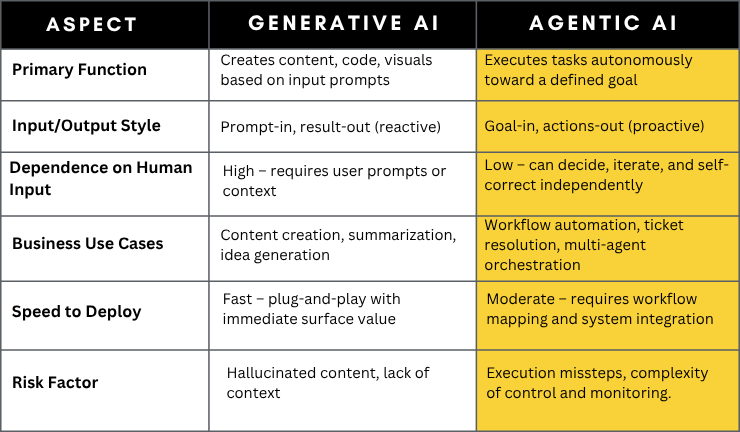
Agentic AI is particularly adept at handling **complex, chained tasks**. This could involve researching a topic, analyzing the findings, writing a report, and then proposing next steps, all without explicit human command for each sub-task. It operates with high autonomy, constantly working towards its set objectives.
Illustrative examples of agentic AI in action include:
- An AI agent managing a complex supply chain, dynamically adjusting logistics based on real-time data.
- An autonomous trading bot that analyzes market trends, predicts price movements, and executes trades automatically to maximize profit.
- A robotic system in a manufacturing plant that performs intricate assembly tasks, adapting to minor variations in components or environmental conditions.
- A sophisticated AI assistant that manages a user’s calendar, schedules meetings, and proactively resolves conflicts.
The Crucial Differences: Agentic AI vs. Generative AI
While both are powerful forms of AI, their fundamental purposes and operational modes are distinct. Understanding these differences is key to grasping their individual applications and future potential.

Here’s a direct comparison:
- Purpose: Generative AI’s purpose is creation and content generation. Agentic AI’s purpose is action, problem-solving, and goal achievement through autonomous operation.
- Autonomy: Generative AI typically has low autonomy; it’s largely prompt-driven and reactive. Agentic AI possesses high autonomy; it’s self-directed and proactive in pursuing its goals.
- Output: Generative AI produces content (text, images, code). Agentic AI produces results or outcomes derived from a series of actions and decisions.
- Interaction: Generative AI primarily interacts through user prompts and its generated responses. Agentic AI interacts with its environment (digital or physical) to achieve its objectives.
- Evaluation: Generative AI is often measured by the **quality of creation** and its relevance to the prompt. Agentic AI is evaluated by the **efficiency and success of achieving its defined outcomes**.
Consider these illustrative scenarios to solidify understanding:
Imagine you need to launch a new marketing campaign.
You might ask a generative AI to “write a compelling marketing email for our new product.” The generative AI will produce the text for the email. This is creation.

Now, imagine you task an agentic AI with the goal: “Increase customer engagement by 15% in Q3.” This agentic AI might:
- Analyze customer data to identify target segments.
- Use generative AI to draft personalized email content for those segments.
- Determine the optimal time to send the emails.
- Deploy the emails through an automated system.
- Monitor campaign performance metrics (open rates, click-through rates).
- Analyze the results, identify what worked and what didn’t.
- Adjust future email content or targeting based on this analysis.
- Potentially even propose new campaign ideas or channels.
Here, the agentic AI orchestrates a series of actions, including leveraging generative AI, to achieve a broader, complex objective. This is action and goal achievement.
The distinction is further clarified by research:
- Generative AI is reactive, while agentic AI is proactive. [Source: Red Hat]
- Generative AI excels at discrete, single tasks, while agentic AI handles complex, chained tasks. [Source: Thomson Reuters]
- Generative AI has low autonomy, requiring user direction for each step, whereas agentic AI operates with high autonomy toward set objectives. [Source: Thomson Reuters]
Understanding AI Evolution: A Historical Context
To truly appreciate agentic and generative AI, it’s helpful to place them within the broader trajectory of artificial intelligence development. AI’s journey began with early, rule-based systems that operated on predefined logic. This evolved into machine learning, where algorithms learn from data without explicit programming. We are now in an era characterized by more sophisticated AI capabilities, including the rise of both generative and agentic forms.
.png)
Generative AI represents a significant leap in AI’s ability to process, synthesize, and create information. It moved beyond mere analysis to active construction. It functions as a powerful **representational engine**, transforming how we think about content creation and data synthesis. [Source: Testrigor]
Agentic AI, on the other hand, signifies a maturation in AI’s capacity for independent reasoning, planning, and executing actions within complex environments. It’s about AI moving from a tool that responds to commands to an entity that can independently pursue and achieve objectives. It operates as an **orchestration framework**, managing multiple steps and considerations to accomplish a task. [Source: Testrigor]
The Collaborative Potential: Generative and Agentic AI Working Together
It’s a common misconception that agentic AI and generative AI are competing technologies. In reality, they are increasingly found to be highly collaborative. Generative AI often serves as a critical component within the cognitive architecture of agentic AI systems. Rather than being mutually exclusive, they are synergistic.

Agentic AI systems can leverage generative AI in several ways:
- Conversation: To interact with users in a natural, conversational manner, understanding queries and providing informative responses.
- Content Creation: To independently generate content as part of a larger task. For example, an agentic AI tasked with writing a report might use generative AI to draft sections of that report.
- Tool Communication: To translate complex instructions or findings into formats that can be understood by other external tools or APIs.
Consider these examples of hybrid systems:
- A customer service agentic AI, tasked with resolving customer issues, might use generative AI to draft personalized, empathetic responses to customer inquiries based on the AI’s understanding of the problem and the customer’s history.
- A research agentic AI, aiming to compile a comprehensive overview of a new scientific discovery, could use generative AI to summarize research papers, extract key findings, and draft an initial report structure, all while the agentic AI itself manages the research process, identifies relevant papers, and ensures accuracy.
- An agentic AI designed to manage a complex software development project could use generative AI to write boilerplate code, generate test cases, or document functions as part of its overall workflow to deliver the project.
The Future Landscape: Trends and Impacts
The evolution of AI is accelerating, and both agentic and generative capabilities are poised to shape the future profoundly.
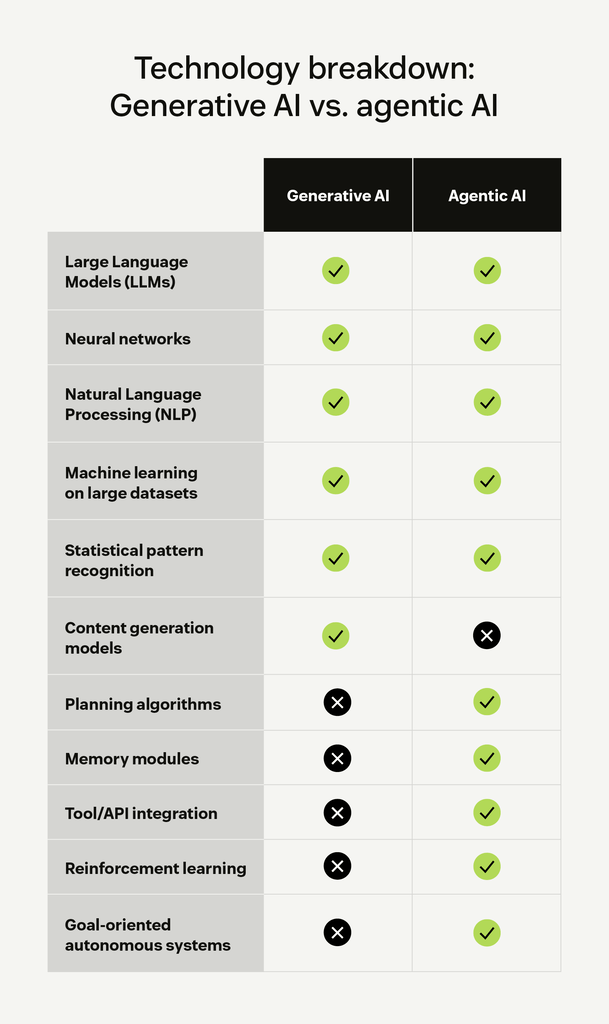
Generative AI Trends 2025: We can anticipate continued advancements in generative AI, including:
- Hyper-personalization: Content will become even more tailored to individual users, preferences, and contexts.
- Multimodal Generation: AI will become more adept at seamlessly generating and integrating different types of media—text, images, audio, and video—within a single output or workflow.
- Deeper Workflow Integration: Generative AI will become more deeply embedded in creative, development, and business workflows, acting as an indispensable co-pilot for various professional tasks.
It’s also worth noting that even current popular chatbot platforms are beginning to demonstrate primitive agentic capabilities by automatically initiating web searches, parsing data, and integrating those findings into their conversational responses. [Source: Red Hat]
Future of AI Automation: Both agentic and generative AI will revolutionize automation across nearly every sector:
- Agentic AI will automate increasingly complex processes, tackling multifaceted problems that require planning, decision-making, and adaptation. This will free up human capital for more strategic, creative, and oversight-focused roles.
- Generative AI will continue to accelerate specific content creation tasks and efficiently handle a wider range of simple questions and answers, improving productivity in information-intensive roles.
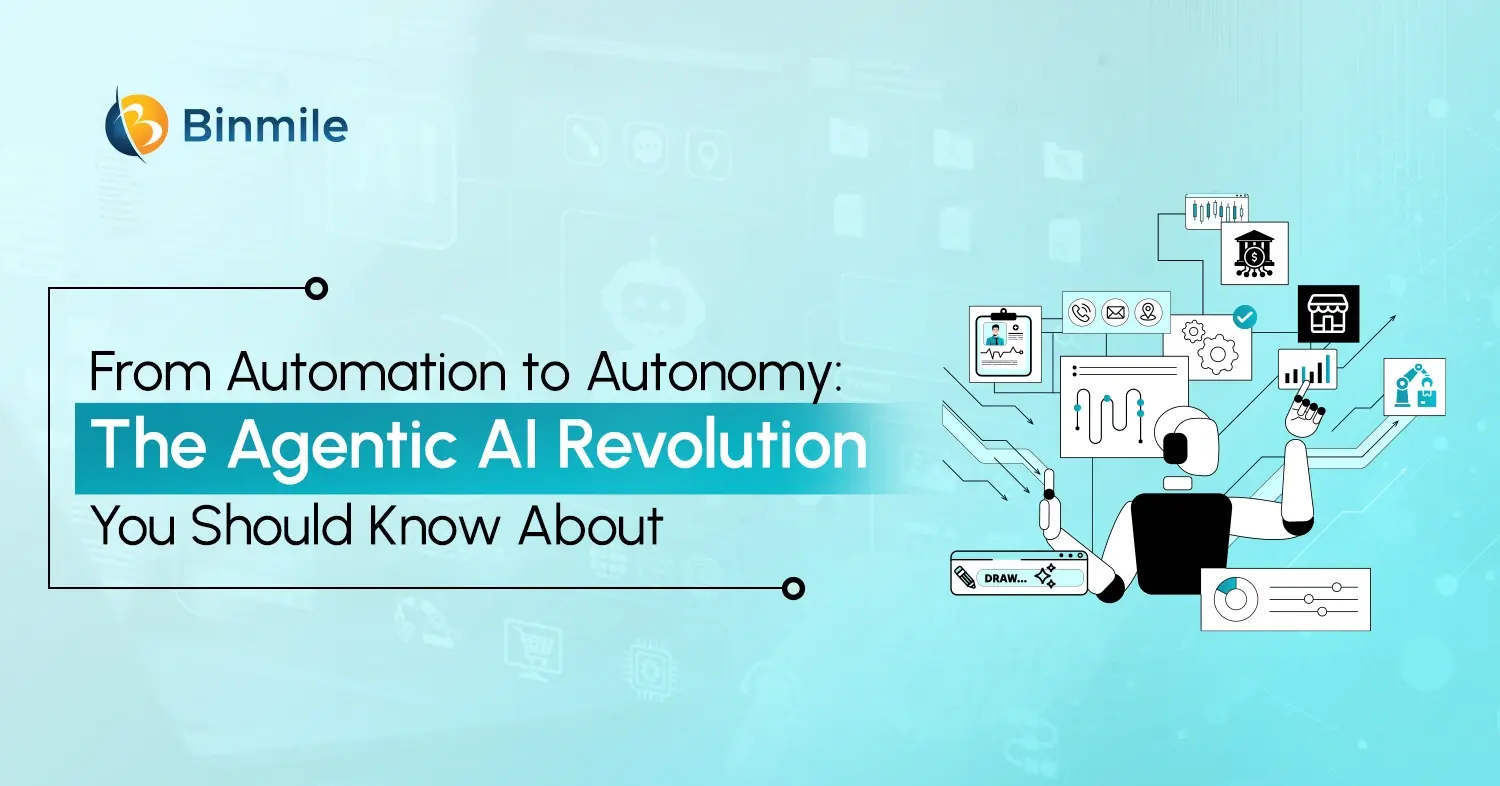
Impact of Agentic AI on Business: The transformative impact of agentic AI on business operations will be substantial:
- Automated Decision-Making: Complex decision-making processes, from financial forecasting to resource allocation, can be automated.
- Predictive Analytics: Agentic systems can proactively identify trends and potential issues before they arise.
- Enhanced Customer Service: Autonomous agents can handle intricate customer interactions, providing personalized and efficient support.
- Operational Optimization: Agentic AI can optimize logistics, supply chains, energy consumption, and other critical operational efficiencies.
For businesses deploying agentic AI, the need for **clear goal definition, robust oversight mechanisms, and well-defined validation checkpoints** for complex actions becomes paramount to ensure safety, efficacy, and alignment with business objectives. [Source: Thomson Reuters]
Looking ahead, we can expect the development of increasingly sophisticated hybrid systems that expertly leverage the distinct strengths of both agentic and generative AI to tackle even more complex problems and drive unprecedented innovation.
Navigating the AI Frontier
As we navigate the rapidly evolving world of artificial intelligence, understanding the fundamental differences between its various forms is essential. At its heart, generative AI is the powerful engine of creation, capable of conjuring new content from vast pools of data. Agentic AI, conversely, is the autonomous actor, designed to perceive, decide, and act with purpose to achieve defined goals.
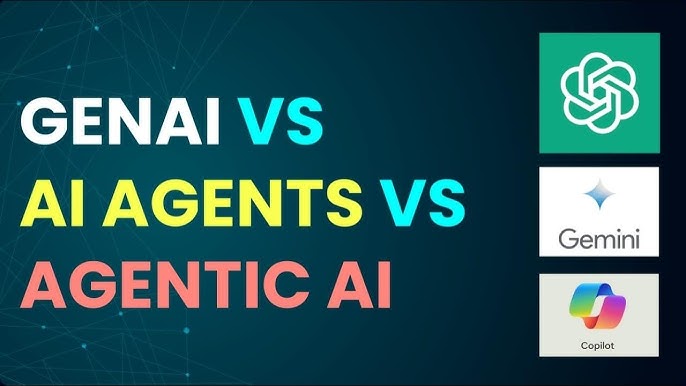
Mastering this framework—this **agentic AI vs generative AI explained** guide—is not merely an academic exercise; it’s crucial for comprehending the trajectory of the **future of AI automation** and the transformative potential it holds across every facet of our lives and industries.
The pace of AI development shows no signs of slowing. These distinct, yet increasingly integrated, capabilities will continue to redefine industries, reshape workflows, and fundamentally alter human-AI interaction. Staying informed and adaptable will be key to harnessing the immense opportunities these technologies present.


